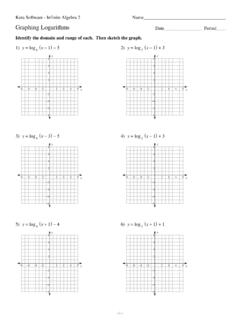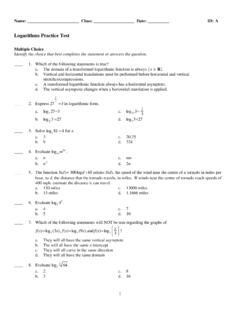Transcription of Unit 5B!!Exponentials and Logarithms
1 Unit 5B Exponentials and Logarithms (Book Chapter 8) Learning Targets: Exponential Models 1. I can apply exponential functions to real world situations. graphing 2. I can graph parent exponential functions and describe and graph transformations of exponential functions. 3. I can write equations for graphs of exponential functions. Logarithms 4. I can rewrite equations between exponential and logarithm form. 5. I can write and evaluate logarithmic expressions. 6. I can graph logarithmic equations. Operations with Logarithms 7. I can use properties of exponents to multiply, divide, and exponentiate with Logarithms .
2 8. I can simplify and expand expressions using Logarithms properties. Solving 9. I can solve exponential and logarithm equations. 10. I can apply solving exponential and logarithm equations to real world situations. Understanding 11. I can apply my knowledge of exponential and logarithmic functions to solve new and non-routine problems. NAME _____ PERIOD _____ Teacher _____ 2 3 Exploring Exponential Models Name _____ Date: _____ After this lesson and practice, I will be able to .. apply exponential functions to real world situations.
3 (LT 1) graph parent exponential functions and describe and graph transformations of exponential functions (LT 2a) ---------------------------------------- ---------------------------------------- ---------------------------------------- --- In the M&M activity, you discovered the formula for _____ functions. In today s lesson, we will continue our introduction of this important family of functions and explore how exponential functions can be used to model many real-life scenarios. Definition 1: Exponential Function The general form of an exponential function is_____ where _____ is the _____-intercept (the starting value ) and _____ is the _____ or _____factor.
4 Both exponential growth and decay are modeled by this equation. - If b > _____, then the equation models exponential _____. - If b < _____ (but greater than _____), then the equation models exponential _____. Example 1: Graph each function. A) !!y=2x B) !!y=3(2)x C) !!y=2012 x D) !!y=1015 x Observe: An _____ occurs at _____. An _____ is a line a graph approaches as x or y approach large absolute values. 4 Example 2: Most automobiles depreciate as they get older. Suppose an automobile that originally costs $14,000 depreciates by one-fifth of its value every year.
5 What is the value of the automobile after 4 years? After years? Use the formula: - Notice, the value of the car after years is not _____ between the values for years 5 and 6. This is because the function is _____, not _____. Oftentimes, rates of growth or decay are given in the form of _____. When this is the case, you can represent the growth or decay factor by _____ if r is a percent increase or _____ if r is a percent decrease. Example 3: Given the percent growth or decay (where + indicates growth, and indicates decay), find r (expressed as a decimal) and b, the growth/decay factor: +30% 75% +2% +110% 3% r = _____ r = _____ r = _____ r = _____ r = _____ b = _____ b = _____ b = _____ b = _____ b = _____ Example 4: Given the following equations, find the percent growth/decay: !
6 !y= ()x!!!!!!!!!!!!!!!y= ()x!!!!!!!!!!!!!!y=2434 x!!!!!!!!!!!!!!y=45()x - First, find r, by using !!b 1. r = _____ r = _____ r = _____ r = _____ - Now write the rate in percent form, and use + to indicate growth, and to indicate decay. _____ _____ _____ _____ Your Turn 1: The value of a video game depreciates exponentially over time. Suppose a video game costs $60 when it is first released and loses 7% of its value every month after it is released. a) Write an equation modeling the value of the video game after n months.
7 B) How much do you expect the video game to be worth after one year? 5 Your Turn 2: The population of Algebratown increases exponentially over time. Suppose the population of Algebratown is currently 12,000 and is increasing by each year. a) Write an equation modeling the population of Algebratown after n years. b) What do you expect the population of Algebratown to be after 20 years? Activity: Representing Linear and Exponential Growth Simple and Compound Interest Applications In the above activity, you compared _____ and _____ functions through the applications of _____ and _____ interest.
8 Since compound interest, represented by _____ functions, can be calculated several different ways, you will learn today how to solve investment problems involving several types of interest. Simple Interest Calculates a percentage of the _____ investment and adds it on each year. Example 5: You invest $2000 into an account that pays 4% simple interest per year. How much money will your account have after 3 years? Compound Interest Calculates a percentage of the amount in the account and adds it on each time interval ( day, month, quarter).
9 In essence, you earn interest on your _____. Use the formula: Example 6: $500 is deposited into an account that pays annual interest. What is the balance in the account after 3 years if the interest is a) monthy? b) weekly? Compound Interest Terminology Semi-annually Quarterly Monthly Weekly Daily 6 Example 7: How much must you deposit into an account that pays interest, compounded semi-annually, to have a balance of $5000 in 15 years? Continuously Compounded Interest Calculates a percentage of the amount in the account and continuously adds it on.
10 Use formula: Important: ____ is a _____. It is a number that frequently occurs in many real-life phenomena. Example 6 continued! $500 is deposited into an account that pays annual interest. What is the balance in the account after 3 years if the interest is compounded continuously? Example 8: How much must be deposited in order to attain $10,000 after 20 years in an account that earns annual interest, compounded continuously? Example 9: How long will it take to double $500 in an account that pays 3% annual interest? For now, solve this question by graphing .
















